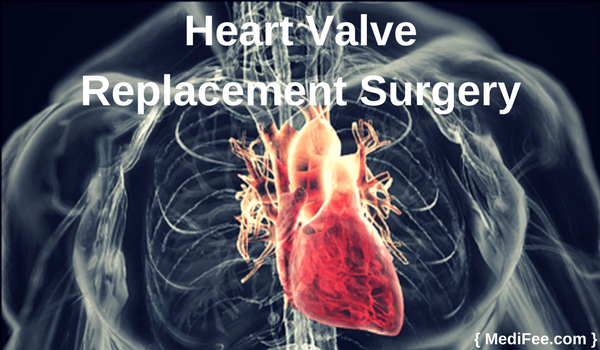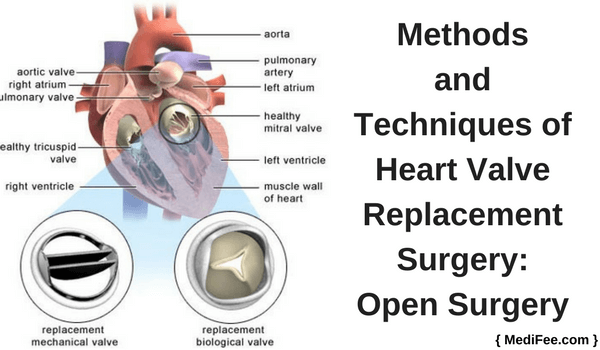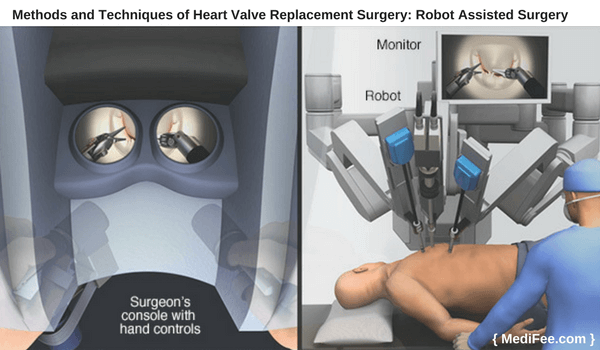Heart Valve Replacement Surgery
Listed below is the step by step procedure of heart valve replacement surgery:
- What is Heart Valve Replacement Surgery?
- Why is Heart Valve Replacement Surgery Required?
- Pre-operative Preparation
- Day Before Surgery
- Procedure Day
- Methods/Techniques of Heart Valve Replacement Surgery
- Post Procedure
- Risks and Complications
What is Heart Valve Replacement Surgery?
Surgical procedures performed for introducing new valves inside the human heart to perform the function of the dysfunctional heart valves comprise heart valve replacement surgeries. Heart is the organ responsible for supplying blood infused with oxygen, to all organs and systems in the body. There are four chambers within the heart through which blood has to pass before being ejected out to rest of the organs. The flow of blood through these chambers occurs in a specific direction only. This direction is controlled by four different valves. They open only in one directions like doors and do not allow blood flow in the wrong direction.

Malfunctioning of these heart valves makes them useless. Surgical methods can be employed to remove such valves from the human heart. New valves synthesized from artificial material or made from animal tissue can be used instead of the old dysfunctional ones. There are several disorders which could necessitate surgery to replace the heart disorders.
Why is Heart Valve Replacement Surgery Required?
Under ideal circumstances, heart valves will facilitate proper blood flow. De-oxygenated blood enters the right upper chamber (Atrium) of the heart. After the tricuspid valve (valve on right dorsal region) opens, the blood flows into the right lower chamber (ventricle). Here, the pulmonary valve opens and the blood moves to the lungs where it is oxygenated.
From lungs, blood enters the left atrium. The purified blood then enters the left ventricle when the mitral valve (valve between left ventricle and atrium) opens. From here, the blood enters the aorta when the aortic valve opens. Aorta is the channel through which the blood is distributed to all other organs.
Any health condition affecting the four valves of heart can alter blood flow from the course that has been described above. These conditions are indicative of heart valve replacement surgery. Some indications for the surgery have been explained below:
Heart valves could fuse together at times. Their structure becomes rigid. This could result in improper or incomplete opening of the valves. Any of the four valves described above could be stenosed (constricted abnormally). Due to stenosis, there is incomplete emptying of blood from the chamber corresponding to the damaged heart valve. As opposed to stenosis, in this condition the valves become loose, their structural integrity is reduced. They cannot hold their position properly. Valves of the heart open only in one direction. But due to leaky valves, some blood may flow opposite to the normal direction as well. Normal blood supply cannot be provided to other organs, as a result. Rheumatic fever is a condition which occurs as a complication of infection by a bacteria named streptococcus. Antibiotic therapy may not work well on this infection and this may progress to rheumatic fever. Heart valves tend to develop rheumatic disease later and may need replacement surgery. Disease of heart muscles is known as cardiomyopathy. It leads to thickening and hardening of the muscles. Heart valves are attached to the muscular walls of the heart. Therefore cardiomyopathy will in turn affect normal movement of heart valves. There is resultant restriction to the blood flow which can cause symptoms. Valvular diseases will lead to symptoms like shortness of breath, swelling of the body, palpitations, weakness, dizziness, chest pain. These can be treated with medicines prescribed by the physician. Some times however, medicines fail to provide relief from the symptoms and could progressively worsen. At such times, surgical intervention might become necessary. Surgical procedures can be employed to treat conditions like valve stenosis and valve insufficiency. Stenosis of valves can be treated by surgically separating the fused valves. The stenosed and rigid valves could be manipulated surgically, in order to make them function normally. Leaky valves can be treated surgically by tightening them to reinforce their structural integrity. This prevents the regurgitation of blood in backward direction. Despite undertaking these methods, the valvular functions may not return to normal. This is an indication that valve replacement surgery may be needed.
Pre-operative Preparation
Any surgery needs proper planning and coordination of several aspects. Multiple factors from the view point of the surgeon as well as the doctor are taken into consideration while planning heart valve replacement surgery. Investigative tests, physical examination, general health check up have to be done for the patient prior to surgery. Some important pre-operative preparations are mentioned below:
- Discussion
The decision to opt for surgery to replace the diseased heart valve is taken after studying the patient's history, performing a physical examination and some investigative tests. Prior to the surgery however, signed consent is needed to be taken from the patient. The surgeon will discuss the surgery in detail with the patient. All the risks, pros and cons of the procedure are explained. Patients can get all their doubts about the surgery cleared from the doctor.
- Investigations
The patient will be asked to get some investigations done prior to the surgery. These are necessary to ensure that there are no obstacles in the course of surgery. Blood tests are done to detect patient's blood group. Blood type matching the patient is kept ready in case transfusion is needed due to excessive blood loss during surgery. Blood sugar levels are also checked.
Heart valve replacement surgery cannot be performed if blood sugar levels are high. It is postponed till they are controlled. White cell count will reveal if any infection is present. Any infection needs to be eliminated with antibiotics before beginning surgery. ECG will give the surgeon an idea about the heart's functioning. Chest X-Ray will reveal the size and structure of the heart and aorta.
- Selection of Valve
As described previously, the diseased valve is replaced with an artificially synthesized valve or biological valves. Artificial valves are prepared using material which will not interfere with the cardiac functions. Biological valves can be used. These are obtained from animal tissue or human tissue. Material to build a biological valve can be taken from the patients themselves. At times, biological valves supported by a frame of artificial material could be used.
Day Before Surgery
One day prior to the surgery, the patient is admitted to the hospital. Consumption of food is discouraged from one night before surgery. The reason for this restriction is that heart surgeries are performed under the effect of general anesthesia. Since the entire central nervous system is desensitized, intestinal movement is a bit lax. If the stomach is full during surgery, there is a chance that its contents may regurgitate and enter the lungs. This could lead to respiratory complications.
A complete physical examination is done for the patient and its report is sent to the surgeon. The patient's blood pressure, heart rate, respiratory rate and body temperature (together comprising the vitals of the patient) are monitored at regular intervals. This is continued during the surgery and also afterwards till the patient regains consciousness. The investigative tests described in the previous section are usually performed a day before the surgery.
The doctor notes names of any other medications the patients may be on. If blood thinners are being taken, they may be stopped for some duration. Patients are often given antacids to prevent acid reflux during the surgery. Laxatives may be prescribed to clear the bowel before surgery.
These are safety precautions to prevent complications during surgery.
Procedure Day
The day of surgery is filled with anticipation for the patient and their family. The patient's vitals are monitored again before the surgery. After being wheeled into the operating room, the patient is dressed in sterile clothing. The skin over the chest and abdomen where the surgical incision will be given is cleaned by shaving off all hair over it. It is splashed with Betadine which is an anti-septic solution. This is done to kill all microorganisms on the skin and prevent infection.
The anesthetist will administer anesthesia through the nose in the form of nasal fumes or it will be injected intravenously in the form of liquid medicine. The effect will set in after sometime. Throughout the surgery, patient's vitals are monitored. Once the patient is completely under the effect of anesthesia, the surgery may begin.
Methods/Techniques of Heart Valve Replacement Surgery
Any of the four valves of the heart can need replacement. The different types of grafts which may be used for the surgery have been described previously in this article under the section 'Pre-operative Preparations.' The procedure however, remains more or less common. Surgery can be performed in different ways which have been described below:
- Open Surgery
The process begins with a single long incision given vertically at the center of the chest. The sternum (breast bone) is removed. A part of the rib cage may also be excised. The valve which is to be replaced is surgically incised. It is replaced with a mechanical or biological valve. The valve is checked for any leaks, regurgitation or rigidity of movement. Once the surgeon ensures that the valve is fitted properly, the sternum is put back in position. The bone will fuse back with the surrounding ribs in a matter of some weeks.

The skin incision is sutured and the procedure ends. During this surgery, a heart-lung machine is used. This machine performs the function of heart for the duration of surgery. It is used since the heart cannot ably pump blood to all organs in the body while it is being operated upon.
- Robot Assisted Surgery
Small surgical incisions are made on the chest wall as opposed to a big one involved in open surgery. Surgical tools are inserted inside the chest cavity to reach the heart through these incisions. Robotic arms controlled by a computer perform the surgery. A video camera inserted inside the chest cavity facilitates visualization of the internal organs. The surgeon operates the robotic arms and performs the surgery.

- Percutaneous Surgery
Also known as transcatheter aortic valve replacement, this surgery is employed solely for the replacement of aortic valve. Approach point for this surgery is the groin or left side of the chest. A new valve is inserted via a small opening at either of these sites. A catheter with a balloon at one end is passed up to the aorta. The balloon will stretch the opening of the old valve. New valve is placed at the site of the old valve. This procedure is carried out without removing the old valve. General anesthesia is not needed for this procedure. Heart-lung machine is also not required.
- Ross Procedure
Like percutaneous surgery, Ross Procedure is also involved in the replacement of aortic valve. This method involves using tissue from the patient's own body to replace the damaged valve. The healthy pulmonary valve is taken from the patient and attached in place of aortic valve. Inturn, tissue of animal origin or tissue which is taken from a human donor is used to replace pulmonary valve.
Post Procedure
- Immediately After Surgery: As soon as the surgery is completed, the anesthetist will start reducing and finally stopping the anesthesia. The patient is transferred to the ICU (Intensive Care Unit) for observation. Vitals are monitored after set periods of time. After regaining consciousness, the surgeon will examine the patient. The surgeon will also decide the duration for which the patient needs to be in the ICU.
- Discharge: Depending on the patient's general health and their response to the surgery, the surgeon may keep the patient under observation in the hospital for about 4-7 days. After being discharged from hospital, the patient still needs to follow some precautions and care instructions.
- Physical Activity: After heart valve replacement surgery, it takes about 4-8 weeks for complete recovery. It is advisable not to indulge into exhaustive physical activity like running, jogging swimming. This will not provide adequate rest to the cardiac muscles. Light physical activity like walking around, stretching exercises, may be started after the surgeon's approval. Lifting heavy weights is strictly not allowed for the initial 4-6 weeks. Driving can be resumed only after 4-6 weeks of surgery if the surgeon approves of it.
- Follow-up: Regular visits to follow up with the surgeon must be done for as long as deemed necessary. The surgeon will perform a general health check up. The surgical incision will be examined for healing of the skin. Stitches which were initially given to hold the incised skin together are removed after the incision has healed well.
- Diet: After heart valve replacement surgeries, patient is advised to follow a light diet for some weeks. The patient should take care not to gain too much of weight. This will put excess of pressure on the heart muscles and the newly placed valve. Intake of fatty food should be controlled to avoid rise in cholesterol levels. Cholesterol tends to get deposited inside the arteries supplying the heart muscles and could even block them. Consumption of alcohol and smoking cigarettes should be restricted after the surgery.
Despite of these care instructions, it is possible for some complications to arise out of the surgery. They have to be treated separately by medicinal or other methods. - Medication: If mechanical valves are used to replace the old valves, the patient has to be on blood thinning medications all the time. This is because the material of which the valve is composed, can react with blood and form blood clots. Complications of these blood clots have been explained in the next section. After the surgery, the patient is prescribed antibiotics to be taken for some duration. This is done to avoid development of infections.
Risks and Complications
- Pain: The surgical incision might be painful for some patients till it heals. The pain can be alleviated by taking analgesics (pain killers).
- Accidental Injury: The organs surrounding the heart like lungs could sustain accidental damage from the surgical tools following injury. This damage can be repaired by other surgical procedures or medicines.
- Bleeding: All the blood in the body circulates through the heart. There are many major blood vessels originating from the heart. Accidental injury to any of these vessels during surgery may cause bleeding. Excessive blood loss can be replenished by blood transfusion.
- Cardiac Tamponade: A layer of tissue known as pericardial sac surrounds the heart. Injury to the sac can lead to accumulation of fluid or blood within. This is known as cardiac tamponade. To avoid this, a tube s inserted within the chest cavity prior to the surgery. It isretained for sometime after surgery to drain excess of fluids.
- Clot Formation: The new valve which is introduced in valve replacement surgery is a foreign body to the heart. Sometimes, blood clots may be formed due to reaction to the material of the valve. These clots can in turn block the blood flow within the heart. Blood thinning medicines can be used in such cases.
- Respiratory Troubles: Formation of blood clots has been explained in the previous point. They may block the arteries supplying blood to lungs. This could lead to breathing difficulties. With proper medicines, these complaints can be treated.
- Replacement of Valve: Biological valves which are made from animal tissue or from another human donor are not permanent. After 10-15 years, they need to be replaced. This is not a complication per say but more of a disadvantage of the process.
More Information related to Heart Valve Replacement Surgery
- Aortic Valve Replacement Surgery
- Mitral Valve Replacement Surgery
- Transcatheter Aortic Valve Implantation (TAVI) Surgery
List of best Cardiac surgeons in India and top cities
List of best Cardio Thoracic and Vascular Surgeons India and top cities
List of best Cardiology Hospitals in India and top cities

